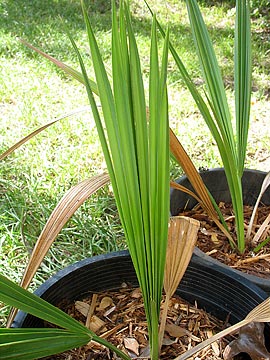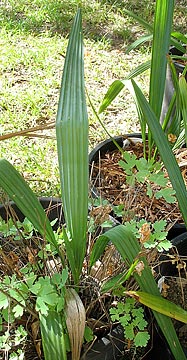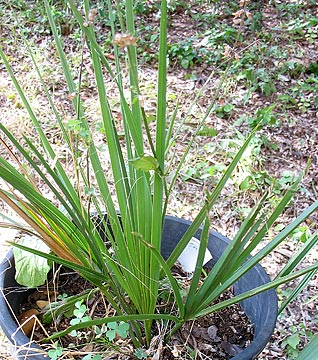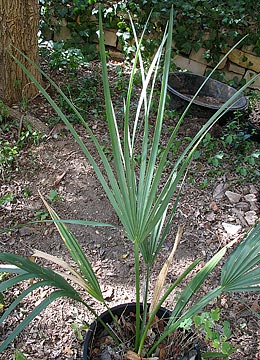Comparison of Sabal 5-year Juveniles, July 2009
5 'types' of Sabal were germinated from seed in 2004: S. mexicana, S. minor,
S. palmetto, Sabal × brazoriensis & Praha Sabal (unclear taxonomic status). Seed were collected as follows:
- S. mexicana from a volunteer plant along Shoal Creek in central Austin.
- S. minor from plants on the U. of Texas campus, next to the Biology pond — destroyed by groundskeepers in 2008.
- S. palmetto from the corner of 6th Street and Lamar Blvd. in central Austin.
- Praha Sabal from large palms in a thicket next to the kiosk below the church in Praha (Fayette Co., Texas).
- Sabal × brazoriensis from a large plant in N. Hays County, originally from a rare native plant project of Prof. Marshall Johnston.
The largest of these plants, now in 5 gallon pots, are shown below, left to right:
S. minor, Sabal × brazoriensis, Praha Sabal, S. palmetto, S. mexicana.
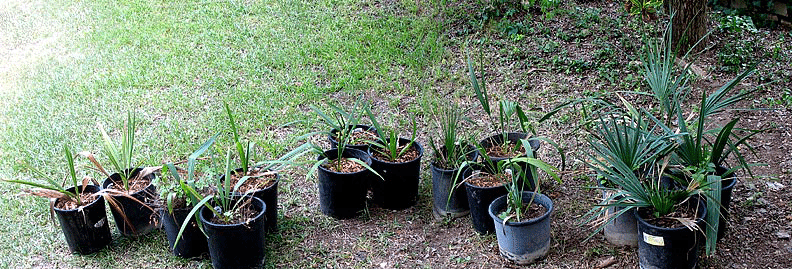
Click on a pot or plant for an enlarged image.
With the exception of the Praha plants (which were under the live oak) these seedlings/juveniles were grown in large pots in two locations:
- For four years in relatively full sun along a creek bank, with the base of the pot in shallow water. When the creek dried up in late 2008 the plants sat in the dry creekbed for several months before being moved into a somewhat shadier location on the creek bank. There had been no deer damage until late winter of 2009, when some young leaves were browsed — clearly a drought effect.
- In the shade of a large live oak (Quercus fusiformis), watered almost weekly. Several of these pots had oak roots that had entered the bottom, undoubtedly robbing the palms of water and nutrients.
Leaf details for the largest of each set are (click for larger image):
With the extended extreme drought in 2009, both the creek and our well ceased to provide water, and in June 2009 I brought the plants into town. Several pots had multiple plants, so I repotted them. In the process of reorganizing the pots, the following similarities and differences among the 5 sets emerged:
- Apart from difference in size and deer damage, the plants of each set were remarkably similar regardless of their external environment.
-
S. mexicana and S. palmetto differed from the others in their development of multi-segmented leaves, as opposed to leaves resembling eophylls (first leaves). Although my data concerning the development of Praha Sabal is limited to this set of plants, evidence from a large population of Sabal × brazoriensis palmettos (both untended volunteer plants and cultivated seedlings in seasonally moist, shady locations) shows that multi-segmented leaves develop very late, most with only bifid leaves after some 12 years.
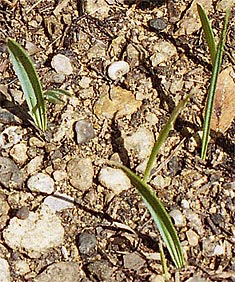
Sabal × brazoriensis eophylls at germination |
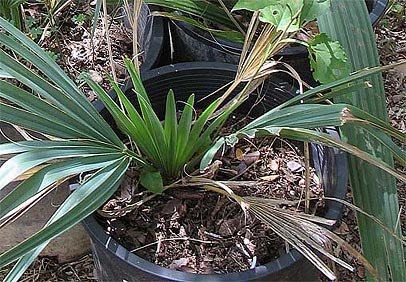
S. mexicana |
These had numerous multi-segmented leaves with filaments (nerves of abscission) and prominent petioles (leaf-stems). S. minor had only just begun to produce several segments. But Praha and Sabal × brazoriensis leaves continued, even with the eighth leaf, with undivided eophyll-like leaves. F. M. Henderson, "Morphology and Anatomy of Palm Seedlings" (2006, Botanical Review 72.287, 324) would seem to consider this a significant aspect of palm ontogeny, since for each species described she notes, when relevant, the number of eophyl-like leaves that precede segmented leaves.
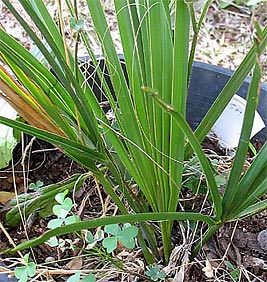
S. palmetto |
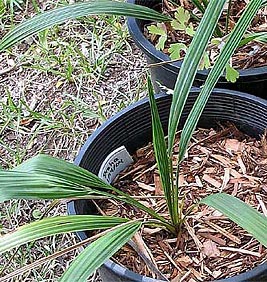
Praha Sabal |
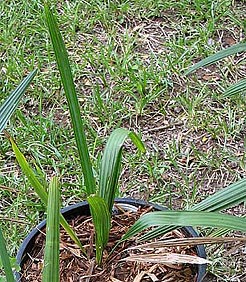
Sabal × brazoriensis |
-
Although all plants exhibited an underground 'saxophone' stem/leaf development, as with leaf development S. mexicana and S. palmetto appeared to be very similar — marked by numerous well-marked leafscars all the way to the base of the plants. In contrast, the other plants showed significantly larger and less clearly delimited leaf scars toward the bottom of the plant. With S. minor it almost seemed that once the meristem had reached a certain point, the nearly 180 degree reorientation of the leaves noted with early S. palmetto saxiphone architecture was replaced by a centrally located meristem leaf formation, protected by layers of previous leaves.
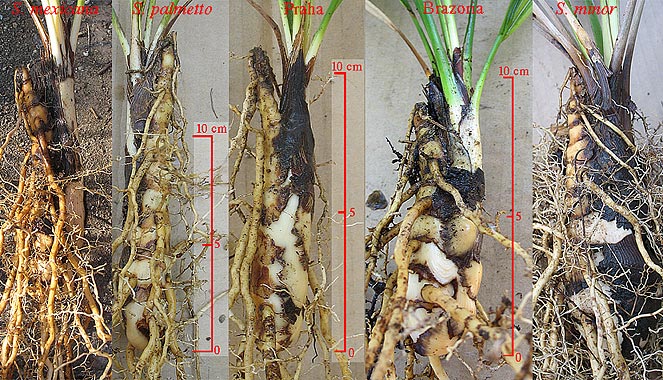
Click on type for larger image.
In short, the Praha Sabal junveniles were not similar to those of S. palmetto but rather seemed more like those of the Sabal × brazoriensis.


